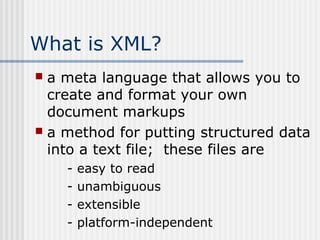
Xml1111
- 1. What is XML? a meta language that allows you to create and format your own document markups a method for putting structured data into a text file; these files are - easy to read - unambiguous - extensible - platform-independent
- 2. What is XML? a family of technologies: - XML 1.0 - Xlink - Xpointer & Xfragments - CSS, XSL, XSLT - DOM - XML Namespaces - XML Schemas
- 3. XML Facts officially recommended by W3C since 1998 a simplified form of SGML (Standard Generalized Markup Language) primarily created by Jon Bosak of Sun Microsystems
- 4. XML Facts important because it removes two constraints which were holding back Web developments: 1. dependence on a single, inflexible document type (HTML); 2. the complexity of full SGML, whose syntax allows many powerful but hard-to-program options
- 5. Quick Comparison HTML - uses tags and attributes - content and formatting can be placed together <p><font=”Arial”>text</font> - tags and attributes are pre-determined and rigid XML - uses tags and attributes - content and format are separate; formatting is contained in a stylesheet - allows user to specify what each tag and attribute means
- 6. Importance of being able to define tags and attributes document types can be explicitly tailored to an audience the linking abilities are more powerful - bidirectional and multi-way link - link to a span of text, not just a single point
- 7. The pieces there are 3 components for XML content: - the XML document - DTD (Document Type Declaration) - XSL (Extensible Stylesheet Language) The DTD and XSL do not need to be present in all cases
- 8. A well-formed XML document elements have an open and close tag, unless it is an empty element attribute values are quoted if a tag is an empty element, it has a closing / before the end of the tag open and close tags are nested correctly there are no isolated mark-up characters in the text (i.e. < > & ]]>) if there is no DTD, all attributes are of type CDATA by default
- 9. A valid XML document has an associated DTD and complies with the constraints in the DTD
- 10. XML basics <?xml ?> the XML declaration - not required, but typically used - attributes include: version encoding – the character encoding used in the document standalone –if an external DTD is required <?xml version=”1.0” encoding=”UTF-8”> <?xml version=”1.0” standalone=”yes”>
- 11. XML basics <!DOCTYPE …> to specify a DTD for the document 2 forms: <!DOCTYPE root-element SYSTEM “URIofDTD”> <!DOCTYPE root-element PUBLIC “name” “URIofDTD”>
- 12. XML basics <!-- --> comments - contents are ignored by the processor - cannot come before the XML declaration - cannot appear inside an element tag - may not include double hyphens
- 13. XML basics <tag> text </tag> an element - can contain text, other elements or a combination - element name: -must start with a letter or underscore and can have any number of letters, numbers, hyphens, periods, or underscores - case-sensitive; - may not start with xml
- 14. XML basics Elements (continued) can be a parent, grandparent, grandchild, ancestor, or descendant each element tag can be divided into 2 parts – namespace:tag name
- 15. XML basics Namespaces: - not mandatory, but useful in giving uniqueness to an element - help avoid element collision - declared using the xmlns:name=value attribute; a URI is recommended for value - can be an attribute of any element; the scope is inside the element’s tags
- 16. XML basics Namespaces (continued): - may define more than 1 per element - if no name given after xmlns prefix, uses the default namespace which is applied to all elements in the defining element without their own namespace - can set default namespace to an empty string to ensure no default namespace is in use within an element
- 17. XML basics key=”value” an attribute - describes additional information about an element <tag key=”value”> text</tag> - value must always be quoted - key names have same restrictions as element names - reserved attributes are - xml:lang - xml:space
- 18. XML basics <tag></tag> OR <tag/> empty element - has no text - used to add nontextual content or to provide additional information to parser <? ?> processing instruction - for attributes specific to an outside application
- 19. XML basics <![CDATA[ ]]> - to define special sections of character data which the processor does not interpret as markup - anything inside is treated as plain text
